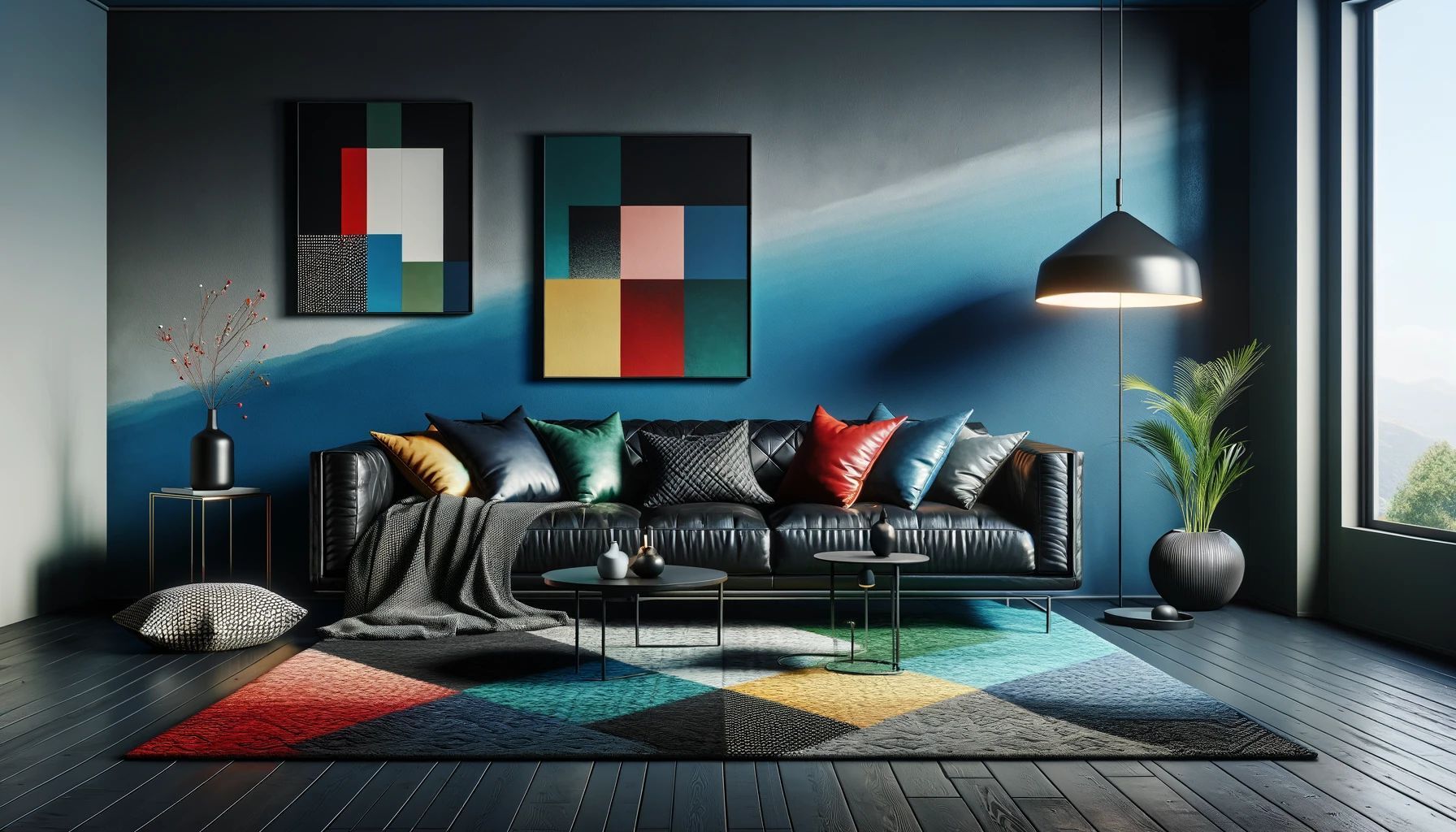Home>Interior Design>6 Colorful Interior Design Teachings You’ll Soak Up From Artist Heather Chontos’ Home


Interior Design
6 Colorful Interior Design Teachings You’ll Soak Up From Artist Heather Chontos’ Home
Modified: August 28, 2024
Discover 6 vibrant interior design lessons from artist Heather Chontos' inspiring home. Enhance your creative space with her colorful ideas and expert advice.
(Many of the links in this article redirect to a specific reviewed product. Your purchase of these products through affiliate links helps to generate commission for Storables.com, at no extra cost. Learn more)
Introduction
When it comes to interior design, finding inspiration can come from various sources. One such source is the homes of talented artists who effortlessly blend colors, textures, and patterns to create stunning spaces. Artist Heather Chontos is a prime example of this, as her home serves as a visual feast for interior design enthusiasts.
Heather Chontos’ home is a showcase of bold colors, unique textures, and curated collections that are sure to inspire anyone who walks through the door. In this article, we will explore six colorful interior design teachings that can be gleaned from her home, offering a fresh and creative perspective on how to transform your own space.
Key Takeaways:
- Embrace bold colors strategically to infuse energy and personality into your space, creating a vibrant and captivating oasis that reflects your unique style and taste.
- Curate collections that showcase your personal interests and passions, infusing your space with character and depth while creating a visually appealing and meaningful design.
Embracing Bold Colors
One of the most striking aspects of Heather Chontos’ home is her fearless use of bold colors. From vibrant blues and yellows to rich reds and greens, every room in her house is alive with energy and personality.
Embracing bold colors in your own interior design can have a transformative effect on your space. It can create a sense of vibrancy and drama, turning a dull room into a captivating oasis. However, it’s important to use bold colors strategically to avoid overwhelming the space.
One tip to effectively use bold colors is to choose a focal point in the room and highlight it with a vibrant hue. For example, you can paint an accent wall in a bold shade or incorporate a statement piece of furniture in a vibrant color. This technique draws the eye and creates a sense of visual interest.
Another approach is to use bold colors in smaller doses through accessories and accents. This allows you to experiment with different colors without committing to a full-scale color scheme. Think colorful throw pillows, artwork, or vibrant curtains that can instantly inject life into a room.
Furthermore, don’t be afraid to mix and match bold colors. Heather Chontos’ home showcases a harmonious blend of different hues, creating a visually captivating and cohesive space. Experiment with color combinations that speak to your personal style and don’t be afraid to step outside your comfort zone.
Remember, embracing bold colors in your interior design should be a reflection of your own personality and taste. It’s about creating a space that brings you joy and energizes your senses. So, don’t hold back and let the colors speak for themselves.
Creating a Sense of Harmony Through Contrasting Hues
One of the key lessons we can learn from Heather Chontos’ home is how to achieve a sense of harmony through contrasting hues. While bold colors are prevalent in her design, they are artfully balanced to create a visually pleasing and harmonious space.
The key to successfully incorporating contrasting hues lies in understanding color theory. Colors that are opposite each other on the color wheel, such as blue and orange or green and red, are considered complementary colors. When used together, they create a striking contrast that brings depth and visual interest to a room.
Incorporating complementary colors can be done through various elements in your interior design. Consider painting one wall in a bold shade of blue and accessorizing with warm orange accents to create a dynamic and inviting space. Or, pair a vibrant green couch with a pop of red in the form of throw pillows or artwork to create a bold and eye-catching contrast.
It’s essential to strike a balance when using contrasting hues. One way to achieve this is by incorporating neutral tones as a backdrop to allow the colors to shine. White or beige walls, for example, can provide a sense of calm amidst the vibrancy of the contrasting hues.
Additionally, consider the intensity of the colors you are using. Mixing high-intensity colors with more muted shades can help create a sense of balance and prevent the space from feeling overwhelming. For example, pairing a soft pastel blue with a vibrant orange can create a harmonious and visually pleasing contrast.
Ultimately, creating a sense of harmony through contrasting hues is about finding the right balance between colors that evoke excitement and colors that provide a calming influence. Look to Heather Chontos’ home for inspiration and experiment with different combinations to find the perfect balance that suits your personal style.
Incorporating Unique Textures and Patterns
One of the defining features of Heather Chontos’ home is her skillful incorporation of unique textures and patterns. Texture and pattern are powerful tools in interior design as they add depth, visual interest, and a sense of personality to a space.
When it comes to incorporating unique textures, consider materials such as natural fibers, reclaimed wood, and textured fabrics. Heather Chontos’ home showcases a mix of smooth surfaces with rough and tactile elements, creating a dynamic and inviting atmosphere. Incorporating these textures not only adds visual interest but also creates a sensory experience.
Introducing patterns into your interior design can also be a game-changer. Patterns can range from geometric shapes to floral motifs, and they can be incorporated through various elements such as wallpaper, textiles, or artwork. Just like textures, patterns add visual intrigue and can help define the theme or style of a room.
When incorporating textures and patterns, it’s important to consider the overall aesthetic you want to achieve. Are you going for a more bohemian look with lots of layered textures, or a sleek and modern design with bold geometric patterns? Choose textures and patterns that align with your desired style and create a cohesive look throughout your space.
Don’t be afraid to mix and match textures and patterns to create a visually stimulating environment. For example, pair a textured jute rug with a floral-printed sofa or combine a striped wallpaper with velvet throw pillows. The key is to find a balance of patterns and textures that complement each other without overwhelming the space.
Lastly, consider the scale of the textures and patterns you are incorporating. Mixing large-scale patterns with smaller-scale textures can add depth and dimension to a room. Experiment with different sizes and combinations to find the right balance for your space.
Incorporating unique textures and patterns is an opportunity to infuse your personality and creativity into your interior design. Look to Heather Chontos’ home for inspiration and embrace the beauty of textures and patterns in your own space.
When incorporating color into your interior design, consider using a mix of bold and neutral colors to create balance and visual interest in the space.
The Art of Mixing Vintage and Modern Elements
Heather Chontos’ home is a masterclass in the art of mixing vintage and modern elements. The juxtaposition of old and new creates a unique and eclectic style that is both timeless and contemporary.
When it comes to incorporating vintage pieces into your interior design, it’s important to choose items that speak to you personally. Vintage furniture, such as a mid-century modern chair or a vintage coffee table, can add character and charm to a room. These pieces often have a story to tell and can become conversation starters.
Pairing vintage pieces with modern elements is a way to create balance and add visual interest. For example, you can place a sleek and minimalist sofa alongside a vintage sideboard, creating a beautiful contrast between old and new. The combination of different eras and styles adds depth and creates a curated and collected look.
One important aspect to keep in mind when mixing vintage and modern elements is to ensure cohesion. Look for common elements or themes that can tie the different pieces together. This could be through color, texture, or shape. Creating a sense of unity will help the vintage and modern elements blend seamlessly.
Another approach is to use vintage accessories and accents to enhance a modern space. Consider incorporating vintage artwork, antique mirrors, or vintage lighting fixtures to add a touch of nostalgia and character to the room. These small details can make a big impact and elevate the overall design.
When sourcing vintage pieces, explore local flea markets, antique stores, or online marketplaces. Embrace the thrill of the hunt and uncover hidden gems that can transform your space. Remember, vintage pieces are often unique and can add a sense of individuality that mass-produced modern furniture may lack.
Overall, mixing vintage and modern elements in your interior design allows you to create a space that is truly one-of-a-kind. Look to Heather Chontos’ home for inspiration and experiment with different combinations to find the perfect balance between old and new.
Read more: How To Soak Up Water From Floor
Playing with Scale and Proportion
Scale and proportion play a vital role in interior design, and Heather Chontos’ home demonstrates the art of playing with these elements to create visually engaging spaces. By understanding the principles of scale and proportion, you can transform your own space and create a sense of balance, harmony, and intrigue.
Playing with scale involves intentionally choosing furniture, decor, and elements that vary in size. Mixing different scales in a room adds visual interest and can create a dynamic and layered design. For example, pairing a large, statement-making chandelier with a relatively small dining table can create a striking focal point and draw attention to the space.
Proportion, on the other hand, refers to the relationship between different elements within a space. It involves ensuring that the size of furniture and accessories is in harmony with the overall size of the room. Proportion helps create a sense of cohesion and prevents any one element from overpowering the space.
One effective technique to play with scale and proportion is through the use of oversized or undersized furniture. By incorporating a piece that is either larger or smaller than expected, you can create a sense of whimsy and intrigue. For example, placing a large, plush armchair in a small reading nook can create a cozy and inviting space.
Another way to play with scale and proportion is through the arrangement of furniture. Experiment with different layouts and groupings to create a visually balanced composition. Mix and match furniture of different heights, sizes, and shapes to create a sense of movement and visual interest.
When it comes to decor, consider the size of wall art, mirrors, and accessories in relation to the wall they are placed on or the furniture they are adorned with. Oversized artwork can make a bold statement, while a cluster of smaller prints can add dimension and personality.
Lastly, don’t forget the importance of negative space. Leaving empty space around furniture and decor items allows for breathing room and helps create a sense of proportion. It also allows each element to stand out and be appreciated on its own merits.
By playing with scale and proportion, you can create visually pleasing and harmonious spaces that captivate the eye. Take inspiration from Heather Chontos’ home and experiment with different sizes, groupings, and placements to find the perfect balance for your space.
Infusing Personality with Curated Collections
Heather Chontos’ home is a testament to the power of curated collections in infusing personality and character into a space. Curating collections allows you to showcase your personal interests, experiences, and passions, creating a truly unique and meaningful design.
A curated collection can encompass a wide range of items, from artwork and books to vintage finds and travel mementos. The key is to select pieces that hold significance to you and reflect your personal style. These collections can become focal points in a room, sparking conversation and adding a layer of depth to the design.
One approach to curating collections is to choose a specific theme or motif. For example, you could create a collection of vintage cameras or a display of postcards from your favorite travel destinations. By focusing on a particular theme, you can create a cohesive and visually appealing arrangement.
Consider showcasing your collections by incorporating open shelves, wall-mounted displays, or dedicated vignettes. Grouping similar items together creates a curated and intentional look. For example, arranging a collection of ceramic vases on a shelf or hanging a gallery wall of artwork can make a striking statement.
When curating collections, it’s important to strike a balance between displaying your items and avoiding clutter. Make sure to leave enough breathing space around each item to allow them to shine. This will also ensure that the collections are visually appealing and not overwhelming to the eye.
Curated collections can evolve and grow over time. Allow yourself the freedom to add new pieces or rotate items from your collection to keep the design fresh and dynamic. This allows you to continuously showcase your personality and tell your unique story through your curated collections.
Remember, a curated collection is an opportunity to express your individuality and create a space that feels truly personal. Look to Heather Chontos’ home for inspiration and start curating your own collections that reflect your passions and interests.
Conclusion
Heather Chontos’ home is a treasure trove of interior design inspiration, teaching us valuable lessons in color, texture, pattern, scale, and personal expression. By embracing these teachings, you can transform your own space into a vibrant and captivating haven.
Embracing bold colors allows you to infuse your space with energy and personality, while creating a sense of harmony through contrasting hues adds depth and visual interest. Incorporating unique textures and patterns adds a tactile and visual dimension to your design, and mixing vintage and modern elements brings character and timeless appeal to your space.
Playing with scale and proportion allows you to create a balanced and visually engaging composition, while infusing personality with curated collections tells a story and adds a personal touch to your home.
By considering these teachings in your interior design journey, you can create a space that reflects your individual style, evokes emotion, and brings joy to your everyday life. Remember to experiment, think outside the box, and let your creativity shine through.
Whether you draw inspiration from Heather Chontos’ bold use of color, her expert curation of vintage elements, or her seamless blending of textures and patterns, remember that interior design is a form of self-expression. It is an opportunity to create a space that truly reflects who you are and what you love.
So, go ahead and unleash your creativity. Let these teachings guide you as you embark on your own interior design journey. Your home should be a reflection of your unique personality, and with these lessons in mind, you can transform your space into a haven that speaks to your soul.
Frequently Asked Questions about 6 Colorful Interior Design Teachings You'll Soak Up From Artist Heather Chontos' Home
Was this page helpful?
At Storables.com, we guarantee accurate and reliable information. Our content, validated by Expert Board Contributors, is crafted following stringent Editorial Policies. We're committed to providing you with well-researched, expert-backed insights for all your informational needs.















0 thoughts on “6 Colorful Interior Design Teachings You’ll Soak Up From Artist Heather Chontos’ Home”